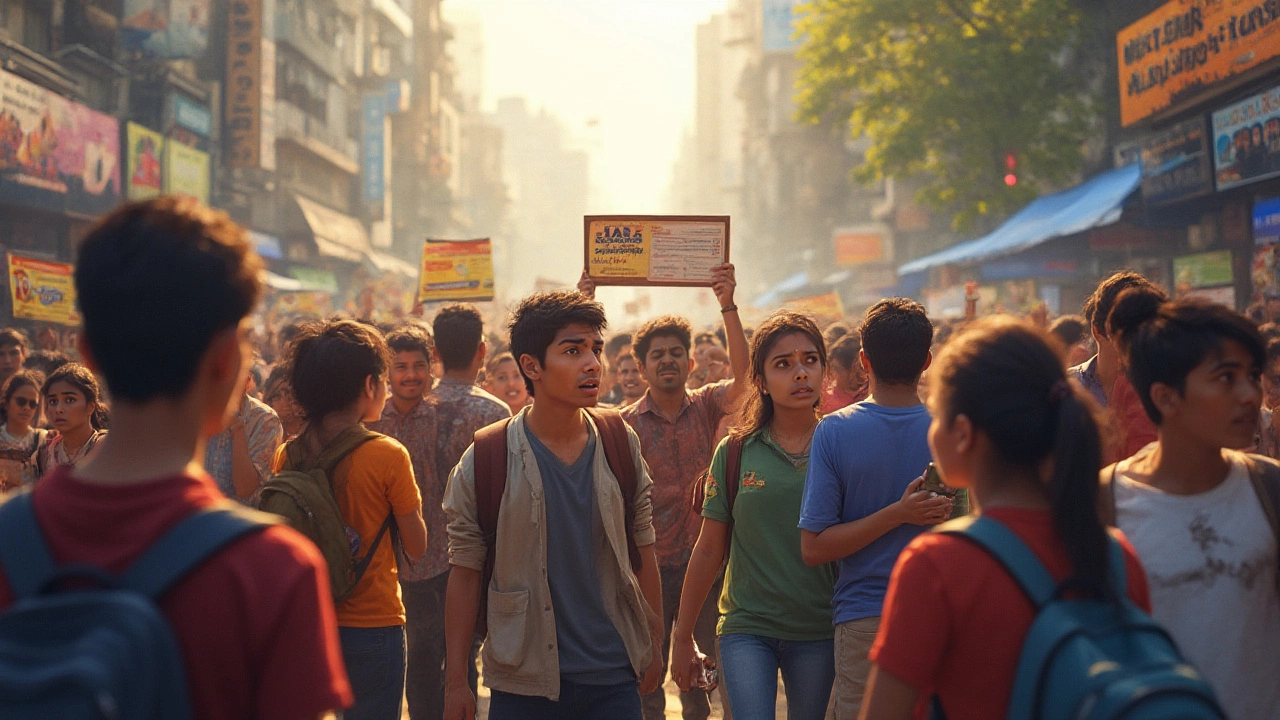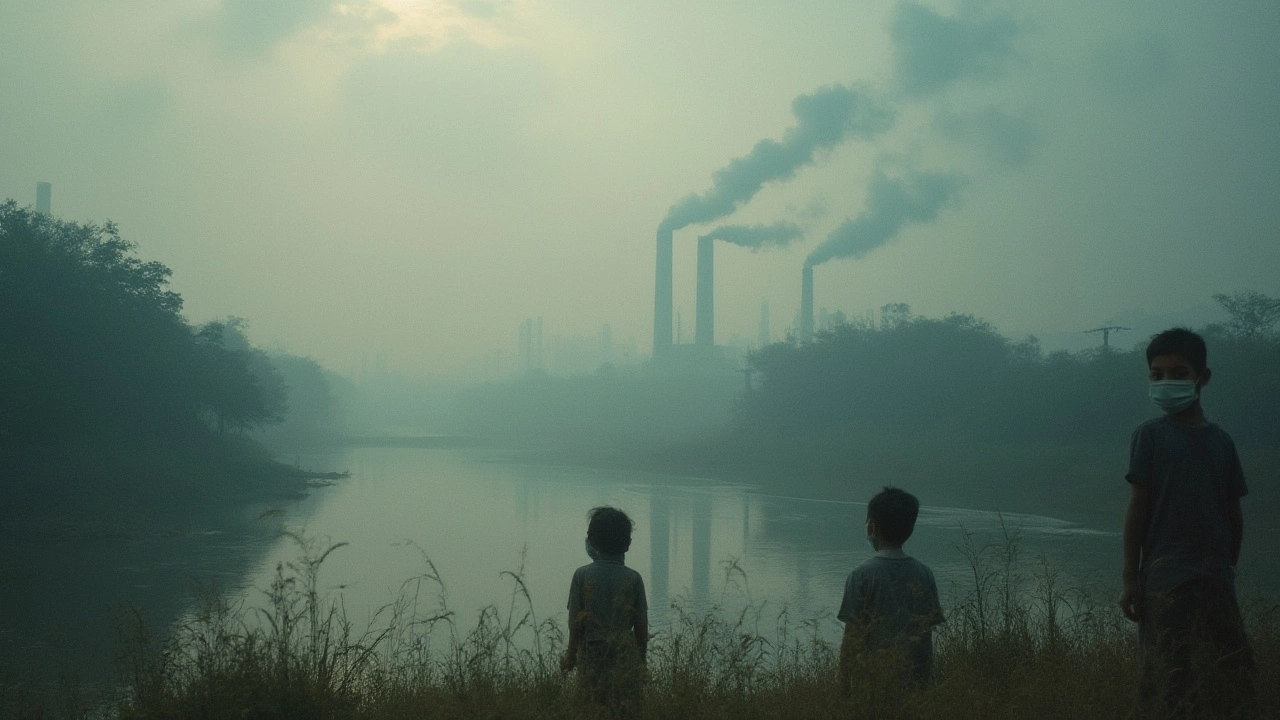
Walk through any market, log onto any news site, or just eavesdrop in a Mumbai autorickshaw—one thing’s clear: India’s biggest concern isn’t hidden in statistics or dry reports. It's present in daily conversations, on social media timelines, and etched on the faces of millions. Some say it’s the price of onions, jobs, air you can’t breathe, or the roads you drive on; others point to schools that don’t teach, rivers that run dry, or apps spreading fake stories. But beneath all this noise, there’s a signal: what matters most to Indians in 2025 isn’t just one problem. It’s the pile-up—the way each issue ricochets into another. So, let’s untangle the mess and see what truly keeps India up at night.
Jobs, Skills, and the Reality Check Nobody Wanted
Unemployment has always loomed over India, but 2025 feels different. Sifting through the latest data isn’t pretty: Unemployment in urban youth, as reported in June 2025 by the Centre for Monitoring Indian Economy (CMIE), sat at a stubborn 16.4%. If you’re just out of college and scrolling Naukri.com for the hundredth time, that number isn’t just a stat—it’s your reality.
The job market isn’t just shrinking. It’s transforming. AI, automation, and remote work mean that jobs your parents dreamt of for you—banker, government clerk, even engineer—may be on the way out or fuse with something else entirely. Reskilling is tossed around as a solution, but let’s be honest, upskilling while working a gig job to pay rent? Easier said than done.
It’s no surprise so many opt for the gig economy, but with few guarantees or benefits, many end up in an uncertain spiral. Over half of India’s workforce depends on informal jobs—think delivery riders, domestic helpers, freelance designers. One rainy month and a broken smartphone can mean zero earnings.
There’s also the hidden story: underemployment. That’s when you take any job, not the one you trained for, just to survive. India produces the world’s largest number of engineers every year, yet a 2024 Aspiring Minds survey found 80% of them struggle to find relevant jobs. The problem isn’t just jobs, but jobs with dignity—and that feels like it’s in short supply.
So what’s working? Well, in states like Karnataka and Maharashtra, government skill centers are trying to plug the gap between education and employers. Startups in Tier 2 cities also bring fresh hope, especially for women who want to work from home. But the finish line is still miles away.
| Year | Percentage |
|---|---|
| 2023 | 12.7% |
| 2024 | 14.3% |
| 2025 | 16.4% |
If you want to prepare, here are a few tips:
- Keep learning: Free courses on sites like Coursera and government platforms can help add new skills, especially tech-related.
- Join a local network or collective—many jobs are shared this way, not just posted online.
- Focus on practical experience, internships, and volunteering—as Indian employers value "jugaad" (street-smart skills) just as much as degrees.
The Air We Breathe, The Water We Drink: Health on the Edge
If you woke up with a sore throat in Delhi this winter or noticed the yellow haze outside your window in Lucknow, you know what’s coming next: pollution. Sometimes it’s the burning in your chest; sometimes it’s just the filmy layer on your window grill. According to India's Central Pollution Control Board, 19 of the world’s 30 most polluted cities are in India—Delhi, Kanpur, Lucknow, Ghaziabad, and Patna top the list.
Pollution isn’t just about air. Rivers—like the Yamuna and Ganga—are choking with foam and plastic. Residents in urban sprawls line up with jerry cans for drinking water, while farmers worry about unpredictable rains, groundwater depletion, and chemical-laden crops. The World Health Organization calculated that in 2024, air pollution contributed to at least 1.6 million deaths in India—nearly 4,400 every single day.
Climate change also amplifies existing problems. Rainy seasons now seem to switch on and off like Wi-Fi signals—unpredictable and patchy. Floods in Kerala, droughts in Bundelkhand, heatwaves in Chennai—all these hit regular people hardest. If you’re not the one getting direct sunlight burns or waterlogged streets blocking your shop, you’re probably coughing up medical bills each month.
While disposable masks and home air purifiers are everywhere, not everyone can afford them. Some communities have taken matters into their own hands. Mumbai’s Aarey activists planted thousands of trees, Noida residents organized plastic-free drives, and Bangalore’s citizen groups fought for lake cleanups. There’s hope in collective action, even if it feels like a drop in the (increasingly polluted) ocean.
| City | Average AQI |
|---|---|
| Delhi | 266 |
| Ghaziabad | 243 |
| Kanpur | 231 |
Trying to protect yourself? Try these ideas:
- Check real-time AQI apps before stepping out; morning hours can be especially harmful.
- Grow balcony plants—they help, even if just a little, with air quality.
- Community action: Even organizing a clean-up or joining a WhatsApp group tracking local pollution alerts can make a difference.

Education: Building Futures or Rote Robots?
Walk into a classroom anywhere from Varanasi to Vishakhapatnam, and you’ll see packed blackboards and students repeating answers in chorus. India boasts of being the world’s largest democracy and maybe the world’s largest school system—but is it working? The 2024 Annual Status of Education Report (ASER) found that nearly 48% of 14-year-olds can’t read a basic newspaper article fluently in any language. That makes you wonder: what exactly are kids learning?
Access to education has improved, but learning outcomes fall flat. Parental anxiety is sky-high—everyone’s scrambling for the best private tuition, coding bootcamps, or residential coaching. Government efforts like the New Education Policy (NEP) 2020 promised transformation: vocational training, less rote, more critical thinking. But five years on, change has been frustratingly slow. Rich kids zip through IB and international schools; poor kids remain tangled in overcrowded government classrooms where chalk is still a luxury.
And then there’s the digital divide. During the 2020–22 pandemic, rural kids without smartphones simply missed out. In 2025, around 36% of homes in rural India still lack reliable internet. If your school teacher posts homework in a WhatsApp group and your family shares one smartphone, you’re always playing catch-up.
It’s not all bleak. Low-cost EdTech like Byju’s or YouTube teachers have definitely helped some. Community-run libraries and learning pods have sprung up nationwide, particularly in Kerala, Tamil Nadu, and Sikkim. But the big gap—between what’s taught and what’s useful, between shiny policies and ground reality—remains India’s real education headache.
If education is your concern, here are some steps to consider:
- For school kids, free online resources like Khan Academy in Hindi, Marathi, and Urdu can boost basics.
- Local NGOs often run after-school clubs—these aren’t just about marks but building confidence and real skills.
- If you’re a parent, try making learning about curiosity, not just rank—even a kitchen experiment or a family history project counts as education.
Information Overload: Trust, Truth, and the WhatsApp Factor
There’s nothing more Indian in 2025 than scrolling through a WhatsApp group chock-full of "breaking news," miracle cures, discount codes, and the occasional wedding invite. With cheap data and everyone from grandmothers to grandkids on smartphones, India now has over 900 million internet users. News spreads faster than you can blink—but so do rumors, scams, and fake stories.
According to a 2025 Reuters Institute report, 61% of Indians say they find it "hard to distinguish between real and fake news online." Sounds dramatic, till you see what happens: stock market swings over a viral hoax, communal clashes fueled by edited videos, or panic buying thanks to false shortage rumors. In the past year alone, over 45 cases of violence could be directly linked to social media misinformation.
That constant digital buzz also affects mental health. Always-on devices lead to higher anxiety—especially for teens and young adults, who now report double the rates of sleep problems compared to a decade ago. Privacy is another growing concern, given new government policies allowing more data monitoring without much transparency.
It’s not all doom and gloom, though. News literacy workshops are popping up in unexpected places—suburban colleges, community centers, and even schools in tiny villages get sessions on how to spot fake news. Telegram and WhatsApp have both introduced fact-checking bots (though they’re not used enough). India’s massive fact-checking movement, led by groups like AltNews and BoomLive, is catching lies before they go viral. Yet, the struggle continues, because the combination of rapid tech growth and low digital literacy means the risk will only grow.
How do you protect yourself?
- Double-check any "breaking news"—look for the same info on a reputable news website, not just social media.
- Install a fact-checking tool or follow fact-checking pages for your daily news.
- Talk to older family members—sometimes, just explaining how viral misinformation works keeps everyone safer.
- Limit screen time. Try a "no phone at the dinner table" rule—it’s tougher than it sounds!
| Year | Percentage |
|---|---|
| 2022 | 48% |
| 2023 | 54% |
| 2024 | 58% |
| 2025 | 61% |
Every Indian walks through a thicket of modern problems every single day—jobs that don’t keep up, air too thick to breathe, classrooms jammed full, news feeds overloaded. What’s striking is how these worries are knotted together. If you want to change your world, fix one thread, but don’t forget how the tapestry connects. Solutions don’t land all at once. But tiny fixes—from community actions to personal boundaries—together nudge the country forward. That’s where the real hope for India lives in 2025.